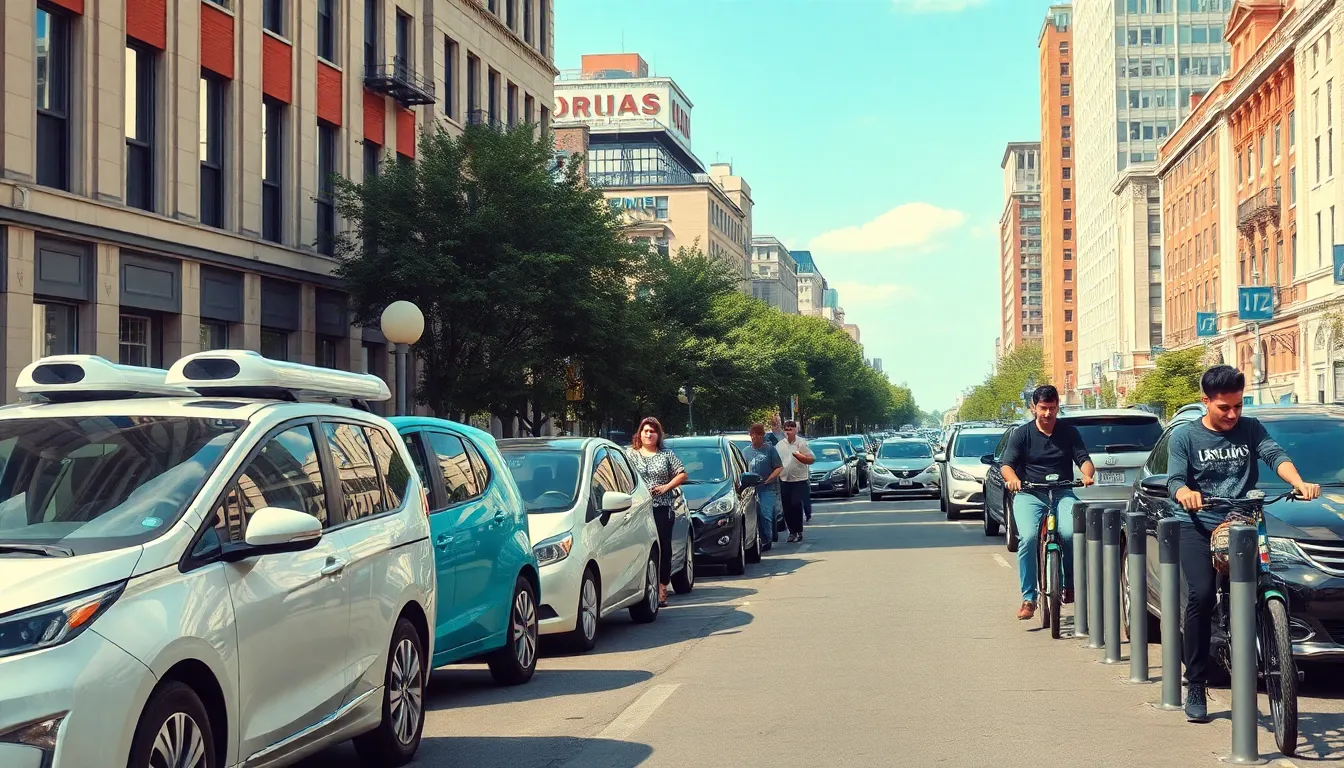The future of mobility isn’t just a buzzword; it’s a rollercoaster ride through innovation that’ll leave you breathless. Imagine zipping around in self-driving cars that practically read your mind, or hopping on a flying taxi that makes rush hour feel like a walk in the park. Sounds like science fiction, right? Well, buckle up because it’s almost here!
Table of Contents
ToggleFuture of Mobility
Future mobility solutions include electric vehicles, which reduce emissions and dependence on fossil fuels. Autonomous vehicles offer convenience and improve safety through advanced AI systems. Public transportation networks are evolving, integrating smart technology to optimize routes in real time.
Air mobility options emerge, with flying taxis poised to change urban transportation. Companies are investing in aerial vehicles capable of vertical takeoff and landing, making air travel more accessible. Regulations in this sector are developing to ensure safety and efficiency.
Shared mobility services are gaining traction, providing flexible transport to urban dwellers. Ride-sharing applications connect users with drivers, reducing the number of vehicles on the road. Biking and scooter-sharing programs encourage sustainable travel, promoting healthier lifestyles.
Infrastructure is also evolving, with smart cities embracing connected transport systems. Traffic management technologies analyze data to enhance traffic flow and reduce congestion. Charging stations for electric vehicles are increasing in availability, supporting the shift toward electric transport.
Sustainability continues to drive innovation. Developing hydrogen fuel cell technology seeks to create cleaner alternatives for long-distance transportation. Collaborations between automotive manufacturers and tech firms are accelerating advancements in mobility solutions.
Dynamic mobility solutions appear to redefine the commuting experience. User-centric designs prioritize comfort, accessibility, and maintenance of personal space. Future trends suggest a blend of personal choice and interconnected systems for seamless travel.
The future of mobility promises exciting transformations as technology and sustainability converge, reshaping how individuals and goods move.
Technological Innovations

The future of mobility hinges on groundbreaking technological innovations. These advancements promise to reshape transportation, enhance efficiency, and promote sustainability.
Electric Vehicles
Electric vehicles play a central role in reducing carbon emissions and dependency on fossil fuels. Currently, the market features a variety of models, providing consumers with choices across price ranges and functionalities. Numerous companies are ramping up production, leading to improved battery technology that extends range and reduces charging times. Consumers increasingly benefit from incentives encouraging adoption, making electric vehicles more accessible. Ultimately, widespread growth in electric vehicle infrastructure supports this transition, with charging stations appearing in urban areas and along major highways.
Autonomous Vehicles
Autonomous vehicles represent a leap in transportation capabilities. Developments in artificial intelligence and machine learning enable these vehicles to navigate roads with little to no human intervention. Companies are conducting extensive testing to enhance safety and reliability. Regulatory frameworks are evolving to accommodate the integration of autonomous technology into existing transportation systems. As a result, autonomous vehicles promise to reduce traffic accidents and improve mobility for individuals unable to drive. Urban environments particularly stand to benefit, as these vehicles could streamline public transport and reduce congestion.
Shared Mobility Solutions
Shared mobility solutions are transforming how people connect with transportation services. Ride-sharing apps, bike-sharing programs, and scooter-sharing services provide flexible options for commuters. Users appreciate the convenience of accessing transportation without the responsibilities of ownership. As urban populations grow, the importance of efficient shared mobility increases, significantly reducing personal vehicle usage. Partnerships between cities and service providers facilitate smoother operation and integration into transportation networks. Overall, shared mobility promotes sustainable practices while enhancing urban mobility.
Environmental Impact
The future of mobility significantly impacts the environment, particularly through innovations that prioritize sustainability.
Reducing Carbon Footprint
Adoption of electric vehicles plays a central role in decreasing greenhouse gas emissions. Studies show that switching to electric options could reduce carbon emissions by 50% in urban areas. Growth in charging infrastructure supports this shift, making electric vehicles more accessible. Concurrently, autonomous vehicles enhance operational efficiency by optimizing routes, leading to fewer emissions. Implementing smart public transport technologies also contributes by increasing passenger numbers and decreasing individual vehicle use. Collectively, these advancements cultivate a cleaner transportation ecosystem and promote healthier urban air quality.
Sustainable Transportation Practices
Sustainable practices are essential for future mobility, emphasizing shared transportation solutions. Ride-sharing services effectively reduce the number of vehicles on the road, lowering congestion while promoting efficiency. Noteworthy is bike and scooter-sharing programs, which encourage eco-friendly travel alternatives. Investment in public transit ensures it remains a viable choice, enhancing accessibility for diverse communities. Smart city initiatives, such as intelligent traffic management systems, further support sustainability by improving traffic flow. These integrated methods represent a commitment to harmonious living between urban development and environmental preservation.
Urban Planning and Infrastructure
Urban planning and infrastructure play crucial roles in shaping the future of mobility. Technological advancements necessitate a reevaluation of how cities design and manage transportation systems.
Smart Cities
Smart cities leverage technology to enhance urban living and mobility. Traffic management systems utilize real-time data to optimize vehicle flow and minimize congestion. Digital platforms provide city residents with information on transportation options and availability. Innovations in infrastructure, such as pedestrian and bicycle-friendly pathways, encourage greener travel choices. Public Wi-Fi access supports connectivity for smart devices, contributing to seamless mobility experiences. Studies illustrate that cities adopting smart technologies can achieve a 25% reduction in travel times, promoting efficiency.
Public Transportation Evolution
Public transportation systems are evolving to meet the demands of growing urban populations. Integration of electric buses and trains reduces emissions, aligning with sustainability goals. Real-time tracking and mobile payment options enhance convenience for commuters. Partnerships with ride-sharing companies streamline last-mile solutions, ensuring smoother connections. Investment in rapid transit lines increases accessibility while decreasing travel durations. Studies show that enhanced public transit can lead to a 30% increase in ridership, reflecting its importance in urban mobility strategies. The shift towards smart public transport solutions plays a pivotal role in reducing reliance on personal vehicles.
Consumer Behavior and Trends
Consumer preferences are shifting rapidly in response to the future of mobility. These changes reflect a desire for more sustainable and efficient transportation options.
Changing Attitudes Toward Transportation
Changing attitudes toward transportation increasingly favor environmentally friendly solutions. Many consumers now prioritize electric vehicles over traditional gasoline-powered cars due to their lower emissions. Research shows a substantial increase in electric vehicle registrations, indicating a growing acceptance. Younger demographics, in particular, lean towards shared mobility options, highlighting preferences for convenience and efficiency. Behavioral studies point to a willingness to adopt ride-sharing and bike-sharing platforms instead of owning personal vehicles. Such choices underscore a broader trend toward sustainability and smart urban living.
The Role of Connectivity and Apps
Connectivity revolutionizes how people navigate transportation systems. Mobile apps serve as crucial tools, providing real-time information on public transportation, shared services, and electric vehicle charging stations. Many users depend on navigation apps to optimize travel routes, enhancing convenience and efficiency. Enhanced connectivity among vehicles, infrastructure, and users promotes a seamless travel experience. Numerous studies confirm that app integration significantly improves user engagement and satisfaction in urban mobility. Increased reliance on smartphones and connectivity solutions shapes consumer expectations, pushing for more integrated and user-friendly transport options.
The future of mobility is set to be transformative as technology continues to evolve. Innovations in electric and autonomous vehicles are paving the way for a more sustainable and efficient transportation landscape. With the rise of smart cities and integrated public transportation systems, urban dwellers can expect a seamless commuting experience that prioritizes convenience and environmental responsibility.
As shared mobility solutions gain traction, they’ll play a crucial role in reducing congestion and promoting eco-friendly practices. The shift in consumer preferences towards sustainable options signals a promising trend in transportation. Overall, the dynamic advancements in mobility will redefine how people and goods move, creating a more connected and sustainable future.





